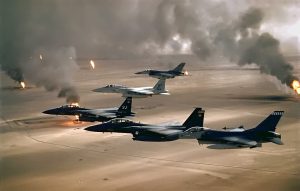
The period from 2020 onward has seen a significant escalation in tensions between Israel and its regional adversaries, primarily Iran and its proxy forces, Hezbollah and Hamas, as well as the more distant Houthi’s of Yemen. This complex web of conflicts and alliances has continued to shape the geopolitical landscape of the Middle East, and has significantly escalated tensions, to the point of a realistic chance for a much-expanded war.
The long-standing animosity between Israel and Islamic revolutionary Iran began to intensify in the early 2020’s. Iran’s nuclear program remained a central point of contention, with Israel consistently opposing any deal that would allow Iran to continue its nuclear development; this attempt at preventing nuclear proliferation, however integral to Israel’s security as it may be, is also highly unrealistic; the assassination of top Iranian nuclear scientist Mohsen Fakhrizadeh in November 2020, widely attributed to Israel, marked a significant escalation, as this differed from the Israeli Mossad’s previous assassination of Mahmoud Al-Mabhouh in Dubai, as the killing of Fakhrizadeh happened within Iran itself.
In this context, Israel is now accused of the assassination of Ismail Haniyeh, Hamas’ political head, who was killed in his hotel room on July 31st, in an apparent drone attack. This, too, occurred in Iran, but in the capital of Tehran itself. While Israel is unarguably at war, following the Hamas offensive of Oct. 7, 2023, an assassination such as this – known as a “decapitation strike” in military parlance – happening in a technically-neutral country (even given the events of April of 2024), is doing Israel no favors internationally.

The Biden administration has proven itself ineffectual with its diplomatic efforts, demonstrating both weakness and incoherence, to the point of encouraging the ambition of the Iranian ruling mullahs.
The election of hardliner Ebrahim Raisi (who was killed on May 19th, 2024 in a helicopter crash while returning from neighboring Azerbaijian) as Iran’s president in 2021 further complicated diplomatic efforts. Raisi’s administration took a more confrontational stance towards both Israel and the West, leading to increased concerns about regional stability.
Meanwhile, Hezbollah – the Iran-backed militant group that has controlled Lebanon’s southeastern Bekaa Valley since the mid-1980’s, remained a significant threat to Israel’s northern border. In 2020 and 2021, there were several minor skirmishes along the Israel-Lebanon border, though both sides managed to avoid a full-scale conflict.
Israel continued to conduct airstrikes in Syria, targeting what it claimed were Iranian weapons shipments to Hezbollah. These operations aimed to prevent the group from obtaining advanced missile systems that could threaten Israeli cities.
In 2022, tensions further escalated when Israel and Lebanon engaged in U.S.-mediated negotiations over their maritime border, which involved disputed gas fields. Hezbollah threatened to attack Israeli gas installations if an agreement wasn’t reached, leading to a tense standoff that was eventually resolved through diplomacy. Now, following a rocket attack on the Israeli Druze community of Majdal Shams on 27 July that killed a number of Druze children, Israel is at the point of invading southern Lebanon to try and attrit Hezbollah’s ability to strike into Israel, much as it attempted in 2006. In this, the ineffectual Lebanese government can offer no resistance against an invasion, or even an “incursion”, and calling on Muslim countries for aid could easily trigger a new civil war in the unstable and bankrupt nation.
In the south, the situation in Gaza remained volatile, with periodic flare-ups of violence between Israel and Hamas, which has retained power in Gaza since 2006, when Hamas won Gaza’s first election – then made sure that no other elections occurred to challenge its grip on power. In May 2021, a significant escalation occurred when Hamas and other militant groups in Gaza fired thousands of rockets at Israel. Israel responded with extensive airstrikes on Gaza, resulting in a 11-day conflict that caused substantial casualties and damage. The aftermath of this short conflict saw increased international pressure for a long-term solution to the Gaza situation. However, progress remained elusive, with Hamas maintaining its control over Gaza and continuing to clash with Israeli forces, which would escalate dramatically on October 7th of 2023.
In 2022 and 2023, there were several smaller-scale exchanges of fire between Gaza militants and Israel. These incidents, while not escalating to the level of the 2021 conflict, served to maintain a state of tension and uncertainty in the region.
The ongoing civil war in Syria that began in 2011, and the unstable situation in Lebanon have provided fertile ground for proxy conflicts involving Israel, Iran, and their respective allies. Israel continued its policy of preventing Iranian entrenchment in Syria through targeted airstrikes, while Iran sought to maintain and expand its influence in the region.
The Abraham Accords, negotiated by US President Donald Trump and signed in 2020, which normalized relations between Israel and several Arab states, altered the regional dynamics. This realignment put additional pressure on Iran and its allies, as Israel’s diplomatic and strategic position in the Middle East was greatly strengthened.
The conflict between these actors is increasingly playing out in the cyber domain. Both Israel and Iran have engaged in sophisticated cyber attacks against each other’s infrastructure, including attempts to disrupt nuclear facilities, water supplies, and electrical grids. For its own part, rumors persist that Israel was at least partly behind the deployment of the highly destructive STUXNET virus in 2010.

Covert operations, including assassinations and sabotage, have become more frequent – as with the assassination of Ismail Haniyeh noted above – as the conflict has evolved. These actions, carried out with only the thinnest veneer of “plausible deniability“, have served to maintain tension without triggering open warfare; that situation, however, may be coming to an end.
The United States remains heavily involved in the region – building on its rocky, 20 years “War on Terror” – by supporting Israel while also attempting to prevent a widening conflict. The Biden administration’s efforts to re-engage with Iran on the nuclear issue met with – being charitable – mixed success, complicated by regional tensions and domestic politics in both the U.S. and Iran, as well as its own failings in the disastrous end to United States adventurism in Afghanistan. The Biden-Harris administration has consistently demonstrated that it cannot make any sort of definitive decision, one way or another, on the diplomatic front.
Russia and China also play significant roles in the Levantine conflict, with Russia maintaining its presence in Syria and with China increasing its economic and diplomatic engagement with Iran. In both cases, Moscow and Beijing figuratively smell blood in the water, as they sense the weakness in NATO [https://en.wikipedia.org/wiki/NATO] as a whole, but also in the United States in particular, as the Biden-Harris team continues to flounder internationally.

The ongoing conflicts and tensions have had severe humanitarian consequences, particularly in Gaza and parts of Lebanon. International organizations repeatedly called for increased access to provide aid and for all parties to respect international humanitarian law. The ongoing war in Gaza following the October 7 massacre, as well as the Houthi strikes against Red Sea shipping, has only made the situation far worse, with Israel now resolved to end the Gaza question once and for all, leading to worsening violence and rhetoric directed against them in the West, with criticism coming from all sides, driving the Israeli mindset further into an “Us Alone Against The World” outlook.
As of early 2024, the situation remained tense and unpredictable. While full-scale war has been avoided so far, the risk of escalation into a much wider war – a war with the potential to draw in larger powers is increasingly possible. The interplay between Israel, Iran, Hezbollah, and Hamas continues to be a major driving factor in regional instability, with implications extending far beyond the Middle East. The international community is attempting to remain engaged, seeking ways to reduce tensions and prevent a larger conflict, but face significant challenges due to systemic internal problems facing Western nations, crushing demographic issues with Communist China, and Russia’s seemingly interminable war in Ukraine.








